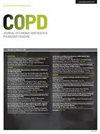Characteristics of Users and New Initiators of Single- and Multiple-Inhaler Triple Therapy for Chronic Obstructive Pulmonary Disease in Germany
IF 3.1
3区 医学
Q1 Medicine
International Journal of Chronic Obstructive Pulmonary Disease
Pub Date : 2024-04-17
DOI:10.2147/copd.s431291
引用次数: 0
Abstract
Purpose: To assess patient characteristics of users and new initiators of triple therapy for chronic obstructive pulmonary disease (COPD) in Germany.Patients and Methods: Retrospective cohort study of patients with COPD and ≥ 1 prescription for single-inhaler triple therapy (SITT; fluticasone furoate/umeclidinium/vilanterol [FF/UMEC/VI] or beclomethasone dipropionate/glycopyrronium bromide/formoterol [BDP/GLY/FOR]) or multiple-inhaler triple therapy (MITT), using data from the AOK PLUS German sickness fund (1 January 2015– 31 December 2019). The index date was the first date of prescription for FF/UMEC/VI or BDP/GLY/FOR (SITT users), or the first date of overlap of inhaled corticosteroid, long-acting β2-agonist, and long-acting muscarinic antagonist (MITT users). Two cohorts were defined: the prevalent cohort included all identified triple therapy users; the incident cohort included patients newly initiating triple therapy for the first time (no prior use of MITT or SITT in the last 2 years). Patient characteristics and treatment patterns were assessed on the index date and during the 24-month pre-index period.
Results: In total, 18,630 patients were identified as prevalent triple therapy users (MITT: 17,945; FF/UMEC/VI: 700; BDP/GLY/FOR: 908; non-mutually exclusive) and 2932 patients were identified as incident triple therapy initiators (MITT: 2246; FF/UMEC/VI: 311; BDP/GLY/FOR: 395; non-mutually exclusive). For both the prevalent and incident cohorts, more than two-thirds of patients experienced ≥ 1 moderate/severe exacerbation in the preceding 24 months; in both cohorts more BDP/GLY/FOR users experienced ≥ 1 moderate/severe exacerbation, compared with FF/UMEC/VI and MITT users. Overall, 97.9% of prevalent triple therapy users and 86.4% of incident triple therapy initiators received maintenance treatment in the 24-month pre-index period.
Conclusion: In a real-world setting in Germany, triple therapy was most frequently used after maintenance therapy in patients with recent exacerbations, in line with current treatment recommendations.
Plain Language Summary: Triple therapy (a combination of three different respiratory inhaled medications) is recommended for patients with chronic obstructive pulmonary disease (COPD) who experience repeated short-term symptom flare-ups when taking dual therapy (a combination of two different respiratory medications). Previously, patients had to take triple therapy using two or three separate inhalers. More recently, single-inhaler triple therapies have been developed, meaning patients can take all three different medications at the same time via one single inhaler. This study assessed the characteristics of patients who were already receiving triple therapy, or who started triple therapy (either via multiple inhalers or a single inhaler), in Germany between January 2015 and December 2019.
In total, 18,630 patients who were already receiving triple therapy during the study period, and 2932 patients who newly started using triple therapy were included. The study reported that more than two-thirds of included patients had experienced at least one flare-up of COPD symptoms in the 2 years before starting triple therapy. Most patients had also received another therapy for COPD before starting triple therapy. A small proportion of patients started taking triple therapy after receiving no other therapy for COPD in the previous 2 years.
The results of the study suggest that triple therapy for COPD in Germany is most often used in accordance with recommendations (patients already receiving therapy and experiencing repeated symptom flare-ups).
Keywords: COPD, Germany, MITT, patient characteristics, real-world treatment, SITT
德国慢性阻塞性肺病单吸入器和多吸入器三联疗法使用者和新启动者的特征
目的:评估德国慢性阻塞性肺病(COPD)三联疗法使用者和新启动者的患者特征:使用 AOK PLUS 德国疾病基金(2015 年 1 月 1 日至 2019 年 12 月 31 日)的数据,对 COPD 患者进行回顾性队列研究,研究对象为单次吸入三联疗法(SITT;糠酸氟替卡松/优甲乐/维兰特罗 [FF/UMEC/VI] 或二丙酸倍氯米松/溴化甘草酸/福莫特罗 [BDP/GLY/FOR])或多次吸入三联疗法(MITT)处方≥1 次的患者。指数日期为首次开具 FF/UMEC/VI 或 BDP/GLY/FOR 处方的日期(SITT 用户),或首次重叠使用吸入式皮质类固醇、长效 β2-受体激动剂和长效毒蕈碱类拮抗剂的日期(MITT 用户)。我们定义了两个队列:流行队列包括所有已确认的三联疗法使用者;事件队列包括首次使用三联疗法的新患者(过去两年内未使用过 MITT 或 SITT)。在索引日期和索引前的 24 个月期间,对患者特征和治疗模式进行了评估:共有18630名患者被确定为三联疗法的流行用户(MITT:17945人;FF/UMEC/VI:700人;BDP/GLY/FOR:908人;非相互排斥),2932名患者被确定为三联疗法的偶然启动者(MITT:2246人;FF/UMEC/VI:311人;BDP/GLY/FOR:395人;非相互排斥)。在流行组和事件组中,超过三分之二的患者在之前的24个月中经历过≥1次中度/重度病情恶化;与FF/UMEC/VI和MITT用户相比,在这两个组中,更多的BDP/GLY/FOR用户经历过≥1次中度/重度病情恶化。总体而言,97.9%的三联疗法使用者和86.4%的三联疗法启动者在指标前的24个月内接受了维持治疗:在德国的实际环境中,近期病情加重的患者在接受维持治疗后最常使用三联疗法,这与当前的治疗建议一致。白话摘要:三联疗法(三种不同呼吸道吸入药物的组合)被推荐用于慢性阻塞性肺病(COPD)患者,这些患者在接受双联疗法(两种不同呼吸道药物的组合)时反复出现短期症状发作。以前,患者必须使用两到三种不同的吸入器进行三联疗法。最近,人们开发出了单吸入器三联疗法,这意味着患者可以通过一个吸入器同时服用三种不同的药物。这项研究评估了2015年1月至2019年12月期间德国已经接受三联疗法或开始接受三联疗法(通过多个吸入器或单个吸入器)的患者的特征。研究共纳入了18630名在研究期间已经接受三联疗法的患者和2932名新开始使用三联疗法的患者。研究报告显示,超过三分之二的纳入患者在开始接受三联疗法前的两年内至少经历过一次慢性阻塞性肺疾病症状的复发。大多数患者在开始接受三联疗法之前也曾接受过另一种治疗慢性阻塞性肺病的疗法。研究结果表明,在德国,慢性阻塞性肺疾病的三联疗法最常根据建议使用(已接受治疗且症状反复发作的患者):慢性阻塞性肺病 德国 MITT 患者特征 真实世界治疗 SITT
本文章由计算机程序翻译,如有差异,请以英文原文为准。
求助全文
约1分钟内获得全文
求助全文
来源期刊

International Journal of Chronic Obstructive Pulmonary Disease
RESPIRATORY SYSTEM-
CiteScore
5.10
自引率
10.70%
发文量
372
审稿时长
16 weeks
期刊介绍:
An international, peer-reviewed journal of therapeutics and pharmacology focusing on concise rapid reporting of clinical studies and reviews in COPD. Special focus will be given to the pathophysiological processes underlying the disease, intervention programs, patient focused education, and self management protocols. This journal is directed at specialists and healthcare professionals
 求助内容:
求助内容: 应助结果提醒方式:
应助结果提醒方式:


